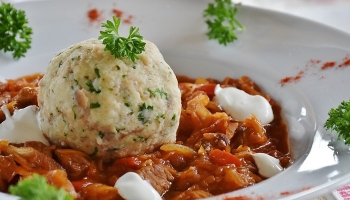Do you wish to eat some lean chicken but have no idea how much to make or how to measure it?
The recommended serving size of chicken is typically three to four ounces. This is an amount of chicken containing between 12 and 20 grams of protein and around 60 to 100 calories, assuming it is baked or grilled.
This amount of chicken can be a great addition to any meal, whether it be some delicious chicken alfredo, chicken quesadillas, or even as an entrée by itself!
Table Of Contents:
- How Much is 3 Ounces Of Chicken?
- 3 Ounces Of Chicken In Grams?
- How Much Protein Is In 3 Ounces Of Chicken?
- How To Measure 3 Ounces Of Chicken?
- How Many Calories Are in 3 Ounces Of Chicken?
- 3 Ounces Chicken Breast Nutrition
- 3 Health Benefits of Eating 3 Ounces of Chicken Every Day
- 2 Delicious Foods That You Can Eat With Your 3 Ounces of Chicken Breast
- Frequently Asked Questions
How Much is 3 Ounces Of Chicken?

An excellent visual comparison to estimate 3 ounces of chicken would be a deck of playing cards. A piece of chicken approximately as wide, thick, and long as a deck of playing cards should be about three or four ounces of chicken.
Another object that would be similar to the same size would be the palm of your hand. While this is a more readily available object to compare your chicken with, it’s not as reliable because everybody’s hands are a little bit different. Playing cards are generally always the same size.
back to menu ↑
3 Ounces Of Chicken In Grams?
As ounces and grams both measure an object’s weight, it does not matter what object you measure. To convert between ounces and grams is always the same. An ounce is about 28 grams, meaning that the weight, ‘three ounces,’ is the same as 84 grams.
Two ounces is equivalent to 56 grams, four ounces is 112 grams, and five ounces is 140 grams. Regardless of the number of ounces, simply multiply that by 28 to find the number of grams. It’s important to note that this does not equal the number of grams of protein, which will always be described as protein (g) or grams of protein.
back to menu ↑
How Much Protein Is In 3 Ounces Of Chicken?
Generally, in plain chicken breast, each ounce contains about 6 grams of protein. That means that a 3-ounce serving of chicken breast would contain about 18 grams of protein. This is very similar to the amount of protein in 3 ounces of beef or pork. However, there is a significantly smaller amount of fat in chicken, giving it a much better protein density in terms of protein per calorie. This makes it a better option for most people with fitness goals such as losing weight or building muscle.
back to menu ↑
How To Measure 3 Ounces Of Chicken?
The most reliable way of measuring your chicken is with a kitchen scale. With a kitchen scale, simply zero the scale out with a plate or bowl on it to hold your chicken. Once it reads zero, start slowly placing the chicken into the plate or bowl and reading the scale after each small portion is added. The scale should read either 3 ounces or 84 grams when you’ve reached the desired three-ounce serving of chicken. If you’ve put too much, take a small piece off and check again.
back to menu ↑
How Many Calories Are in 3 Ounces Of Chicken?
Generally speaking, there are about 30 calories in each ounce of chicken breast. In three ounces, there will be about 90 or 100 calories. The vast majority of these will come from protein, usually over 80% of them, and the remaining few will come from fat. There is no significant amount of carbohydrates in plain chicken. However, the same can not be said for breaded or deep-fried chicken. Breaded and deep-fried chicken can contain as much as 200 or 250 calories in three ounces, but it can still be a part of a healthy balanced diet.
3 Ounces Freid Chicken
For fried chicken with extra fat content, the three-ounce serving size is a more important factor, while eating much larger amounts of boneless, skinless chicken breast, for instance, can be a very healthy choice. Grilled or baked chicken breast would be considered keto friendly and would be a great food to eat on a low-carb diet.
back to menu ↑
3 Ounces Chicken Breast Nutrition
In three ounces of chicken breast, you should expect about 90 calories, 18 grams of protein, and 1 gram of fat. Chicken breast also contains Vitamin B, Vitamin D, calcium, iron, and zinc. It’s one of the healthiest foods available for any non-vegetarian.
back to menu ↑
3 Health Benefits of Eating 3 Ounces of Chicken Every Day

Lean chicken is one of the most protein-dense foods on the planet. Not only is it low in fat, but it lacks carbohydrates entirely. The vast majority of calories in chicken breast come from protein. In case you don’t know, protein is the building block of your body’s tissues. Muscles, tendons, and ligaments all rely on protein intake to rebuild and strengthen themselves.
One
One big benefit to eating chicken every day is that it will be easier to build muscle tissue! If you are trying to bulk up, protein is your best friend, and chicken packs a lot of it. It’s one of the most reliable ways of hitting your protein goals, often containing more densely stored protein than protein powders.
Two
Another benefit to eating 3 oz chicken is that it can help with brain development. Chicken contains many valuable nutrients like Vitamin B12, choline, and niacin which aid in the development and well-being of brain and nervous tissue.
Three
When replacing red meat, eating chicken can help you to lose weight! This is because to consume the amount of protein your body needs, you won’t have to consume nearly as many calories of chicken as you would with beef or pork. This is due to the low-fat content in chicken. Fish is also very protein-dense meat that can provide the same benefit. However, keep in mind that this doesn’t necessarily apply to breaded and deep-fried fish and chicken. If you’re looking for an alternative to traditional deep-fried chicken wings, San Tung Chicken Wings are an amazing choice!
back to menu ↑
2 Delicious Foods That You Can Eat With Your 3 Ounces of Chicken Breast
There are countless combinations of foods you can use to make your chicken dishes more filling and satisfying, as well as add much-needed flavor. One such dish is a chicken fajita. Even simply cooking down some onions and peppers in the pan before throwing in your chicken and rolling that up into a tortilla can create a powerful explosion of flavor and balance out the nutrients in the dish. Don’t forget to add some seasoning!
I recommend garlic salt and chili powder, and if you want to cut the spice, a bit of lemon or lime juice makes a great addition. You can also make these into fajita quesadillas by adding cheese! A great pan to use for making quesadillas or fajitas would be a Comal pan!
The Second Dish
Another great option is to eat your chicken with rice and broccoli. Now I know what you’re thinking, that’s boring and bland. And you’re right, it can be. Personally, I would use a little bit of butter or zero-calorie non-stick spray in the chicken and add garlic salt, pepper, and chili powder.
If you’re really into spicy foods, you can even add some cayenne pepper, and trust me, if you do, it will not be a boring dish anymore! Another great option to add to chicken would be pasta. A great chicken spaghetti or chicken alfredo is always a hit with children and adults alike! If you’re planning to make some pasta, you may be wondering, “How much is 2 oz of pasta?”
back to menu ↑
Frequently Asked Questions
Is 3 Oz chicken enough for dinner?
Three ounces of chicken will be enough for most people to consume per meal to reach the recommended amount of daily protein intake of about 50 grams. However, if dinner provides you with more than one-third of your daily protein, it may be appropriate to eat 6 ounces of chicken or more. For people trying to build muscle, for instance, it would be normal to consume 8 to 12 ounces of chicken in a single sitting.
Three ounces may not sound like enough to make dinner satisfying. Personally, I can relate to this. However, if you combine it with other foods like vegetables and starches, you can probably make a well-balanced meal that will satisfy you.
back to menu ↑
How much cholesterol is in 3 Oz chicken breast?
Three ounces of chicken breast contains approximately 75 milligrams of cholesterol. This is about the same amount or more than some types of pork and beef, meaning it won’t be the best choice if you are on a low-cholesterol diet. However, three ounces of chicken daily is unlikely to cause any cholesterol-related issues for previously healthy individuals.
back to menu ↑
Are 3 ounces of chicken enough for a gym person?
For someone looking to lose weight and maintain their muscles or someone looking to build muscle, three ounces of chicken may not be enough. Only having 18 grams of protein, you’re likely going to want to consume four to five times that amount daily. Obviously, not all of this needs to come from chicken or even meat, but 80 to 100 grams of daily protein would be optimal.
It’s widely agreed upon that 0.4 grams of protein per pound of body weight would be able to support goals like this. This protein can come from nuts, grains, whey, meats, dairy, seeds, soy, and more.
back to menu ↑
How much is 3 Oz of chicken in cups?
If your chicken is shredded or ground, you could easily measure it in cups. Three ounces is a sort of awkward amount of chicken to measure in cups, as it fills about 60% of a cup. That means it will be just over a half cup. Fifteen ounces will fill three cups fully, but this may only be helpful if making a multiple-serving batch of chicken at once. Regardless, the most reliable way to measure chicken would be by weight.
back to menu ↑
How many ounces of meat are in an average chicken thigh?
Conveniently enough, one average chicken thigh will contain about three ounces of meat, excluding the bones. Drumsticks will average about one and a half ounces. This can be a useful, albeit rough, estimate for the amount of chicken you’ve eaten. Again, weighing the meat, excluding bones, will always be the most reliable way to measure your chicken.
back to menu ↑
How many ounces of chicken should I eat for muscle?
A commonly agreed-upon amount of protein intake for muscle synthesis is 0.4 grams per pound of body weight. This means 60 grams for a 150-pound individual, 80 grams for a 200-pound individual, and 100 grams for a 250-pound person.
This is usually enough to elicit an appropriate response in protein synthesis, but more protein will not be wasted at this threshold. Additional protein doesn’t appear to be completely wasted until closer to the 1 gram per pound of body weight intake level. However, past 0.4 grams per pound of body weight, the diminishing returns begin to kick in, and each extra gram is able to do less and less for your muscles.
Shanny
Shanny not only has an exceptional understanding of the foodie mindset and how nutrition works, she has also achieved her Master’s Degree in Education. Outside of her academic achievements, she loves writing food blogs. It's so much more than a list of meals though! Shanny creates helpful cookware guides and delicious recipes that are easy to follow. She does all of this as a food blog writer because she loves it. That's why she spends lots of time testing out different recipes in her own home. She truly is a one-of-a-kind foodie, from her home to yours - with a story to tell, new recipes to indulge in and new tips to tantalize those tastebuds.












